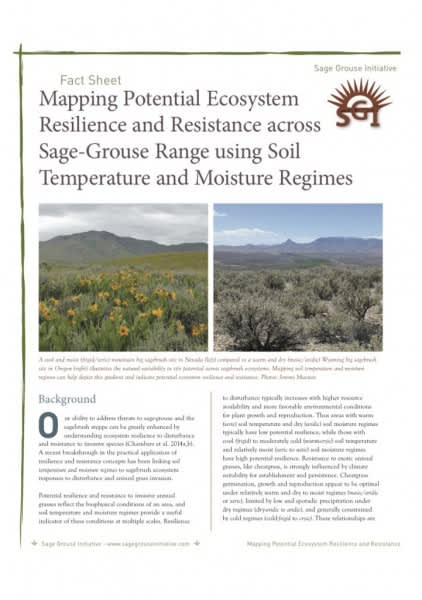New Publication Helps Land Managers Strategically Reduce Wildfire and Invasive Species Threats in Sagebrush Ecosystem
OutdoorHub 09.08.14

Wildfire and invasive species pose great challenges to the future of sage grouse and the sagebrush ecosystems of the West. Today, managers have a new approach for prioritizing and targeting efforts to reduce these threats with the publication of a significant report, Using Resistance and Resilience Concepts to Reduce Impacts of Invasive Annual Grasses and Altered Fire Regimes on the Sagebrush Ecosystem and Greater Sage-Grouse: A Strategic Multi-Scale Approach. (Published by the U.S. Forest Service Rocky Mountain Research Station, General Technical Report 326).
The new report resulted from the combined efforts of a working group of wildlife biologists, rangeland and restoration ecologists, fire specialists, soil scientists, and land managers convened by the Western Association of Fish and Wildlife Agencies.
The publication combines current understanding of sage grouse habitat needs and sagebrush ecosystem dynamics into a framework for applying strategies intended to reduce fire and invasive species threats. The publication provides a transparent, multi-scale approach designed to help land managers prioritize scarce resources when addressing complex ecosystem problems. Already, the work is proving helpful for rangewide applications. The Bureau of Land Management is currently using the publication’s strategic approach to guide their efforts as the agency addresses fire and invasives in the Great Basin as part of the Resource Management Plan revision process.
Mapping potential ecosystem resilience and resistance across sage-grouse range using soil temperature and moisture regimes
The key breakthrough in the new report is linking soil and temperature moisture regimes to the way sagebrush ecosystems respond to disturbance and annual grass invasions. Simply put, the warmer the temperatures and the drier the soils, the less resilient sagebrush ecosystems are to invasives and fire. The cooler and the wetter the soils, the more resilient and resistant are sagebrush ecosystems to these threats.
A new geospatial data product is now available that compiles available soil survey data across the range of sage grouse. Practitioners can use the product to display soil temperature and moisture regimes as an indicator of potential ecosystem resilience and resistance. A seamless, rangewide layer is available for landscape planning purposes. Additional detailed geodatabases allow for more in-depth analyses at the site scale.
A new fact sheet provides managers with a description of the product, links to downloads, and instructions for application.
Contact:
Jeremy Maestas, SGI Technical Lead, NRCS
Contact: 541.923.4358 ext. 109
Email: jeremy.maestas@or.usda.gov

